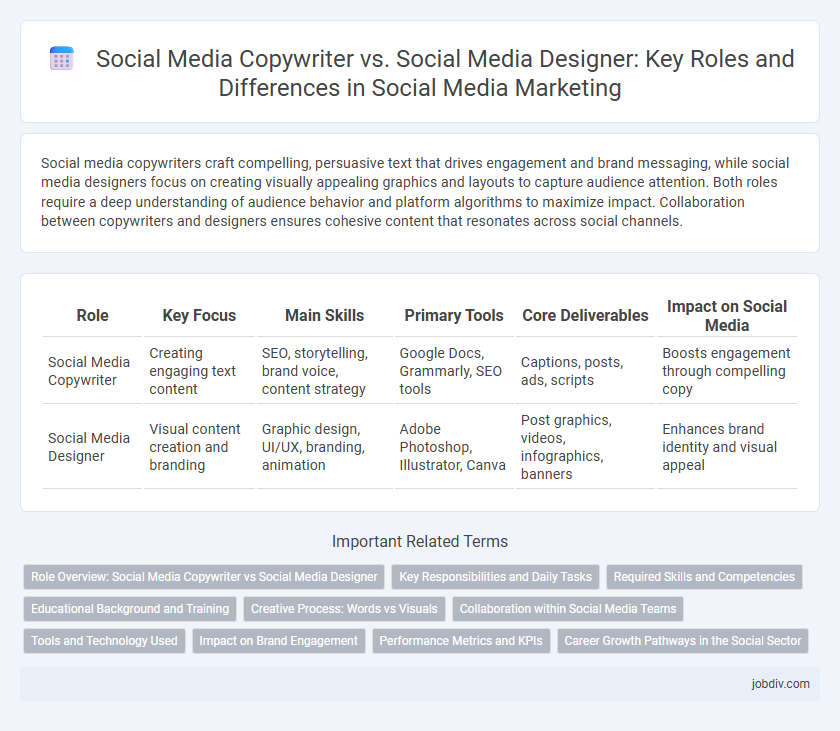Social media copywriters craft compelling, persuasive text that drives engagement and brand messaging, while social media designers focus on creating visually appealing graphics and layouts to capture audience attention. Both roles require a deep understanding of audience behavior and platform algorithms to maximize impact. Collaboration between copywriters and designers ensures cohesive content that resonates across social channels.
Table of Comparison
| Role | Key Focus | Main Skills | Primary Tools | Core Deliverables | Impact on Social Media |
|---|---|---|---|---|---|
| Social Media Copywriter | Creating engaging text content | SEO, storytelling, brand voice, content strategy | Google Docs, Grammarly, SEO tools | Captions, posts, ads, scripts | Boosts engagement through compelling copy |
| Social Media Designer | Visual content creation and branding | Graphic design, UI/UX, branding, animation | Adobe Photoshop, Illustrator, Canva | Post graphics, videos, infographics, banners | Enhances brand identity and visual appeal |
Role Overview: Social Media Copywriter vs Social Media Designer
A Social Media Copywriter specializes in creating engaging, persuasive written content tailored to target audiences across platforms like Facebook, Instagram, and Twitter, driving brand messaging and user interaction. A Social Media Designer focuses on visual content creation, crafting compelling graphics, videos, and layouts that enhance brand identity and increase engagement through appealing aesthetics. Both roles collaborate to boost social media presence, but the copywriter emphasizes strategic language while the designer prioritizes visual storytelling.
Key Responsibilities and Daily Tasks
Social Media Copywriters craft compelling and persuasive content tailored to target audiences, focusing on brand voice and engagement metrics. Social Media Designers develop visually appealing graphics and multimedia assets, emphasizing user experience and platform-specific design standards. Both roles collaborate closely to ensure cohesive messaging and optimized social media campaigns that drive audience interaction and brand growth.
Required Skills and Competencies
A Social Media Copywriter excels in crafting engaging, concise, and persuasive content tailored to target audiences, emphasizing strong writing skills, creativity, and a deep understanding of SEO and brand voice. A Social Media Designer focuses on visual storytelling, requiring expertise in graphic design, proficiency with tools like Adobe Creative Suite, and an eye for aesthetics and user engagement. Both roles demand strategic thinking and adaptability to evolving social media trends, but the Copywriter prioritizes linguistic impact while the Designer centers on visual influence.
Educational Background and Training
Social media copywriters typically have educational backgrounds in communications, marketing, or journalism, emphasizing skills in persuasive writing and content creation. Social media designers often possess training in graphic design, visual arts, or multimedia, focusing on visual storytelling and brand aesthetics. Both roles benefit from courses in digital marketing platforms, but copywriters prioritize language proficiency while designers emphasize software proficiency like Adobe Creative Suite.
Creative Process: Words vs Visuals
Social Media Copywriters focus on crafting compelling narratives and persuasive language that resonate with target audiences, driving engagement through carefully chosen words and storytelling techniques. Social Media Designers specialize in creating visually appealing graphics, layouts, and multimedia content that capture attention and enhance message clarity across platforms. The creative process for copywriters centers on linguistic creativity and emotional impact, while designers prioritize visual aesthetics, color theory, and composition to communicate brand identity effectively.
Collaboration within Social Media Teams
Social Media Copywriters craft compelling messages that engage target audiences, while Social Media Designers create visually appealing graphics that enhance content impact; their collaboration ensures cohesive brand storytelling across platforms. Effective teamwork between these roles leads to synchronized campaigns that balance persuasive language with striking visuals, driving higher engagement rates and brand loyalty. Integrating copywriting and design processes early in project planning fosters innovation and consistency within social media teams.
Tools and Technology Used
Social media copywriters primarily use content management systems, SEO tools like Google Analytics and BuzzSumo, alongside writing platforms such as Grammarly and Hemingway Editor to craft engaging, optimized text. Social media designers rely heavily on graphic design software including Adobe Creative Suite (Photoshop, Illustrator), Canva, and video editing tools like Adobe Premiere Pro to create visually compelling posts. Both roles increasingly integrate scheduling tools such as Hootsuite or Buffer to streamline content publication and audience engagement.
Impact on Brand Engagement
A Social Media Copywriter crafts compelling and persuasive messages that resonate emotionally with the target audience, driving higher brand engagement through clear and impactful storytelling. In contrast, a Social Media Designer creates visually appealing content that captures attention quickly and enhances brand recognition, making posts more shareable and memorable. Both roles are essential for maximizing overall brand engagement by combining strong narrative with striking visuals tailored to diverse social platforms.
Performance Metrics and KPIs
Social media copywriters primarily impact engagement rates, click-through rates (CTR), and conversion metrics by crafting compelling, targeted content that drives audience interaction. In contrast, social media designers influence visual appeal metrics such as shareability, time spent on posts, and overall brand consistency, which indirectly boosts follower growth and retention. Effective performance analysis combines KPIs from both roles, linking creative messaging with design effectiveness to optimize campaign ROI.
Career Growth Pathways in the Social Sector
Social media copywriters develop content strategy skills, mastering audience engagement and brand voice, which opens pathways to content management and marketing director roles. Social media designers enhance visual communication and user experience expertise, advancing toward creative director or digital design leadership positions. Both career trajectories offer upward mobility within social, nonprofit, and advocacy organizations, driven by digital strategy and audience impact proficiency.
Social Media Copywriter vs Social Media Designer Infographic

 jobdiv.com
jobdiv.com